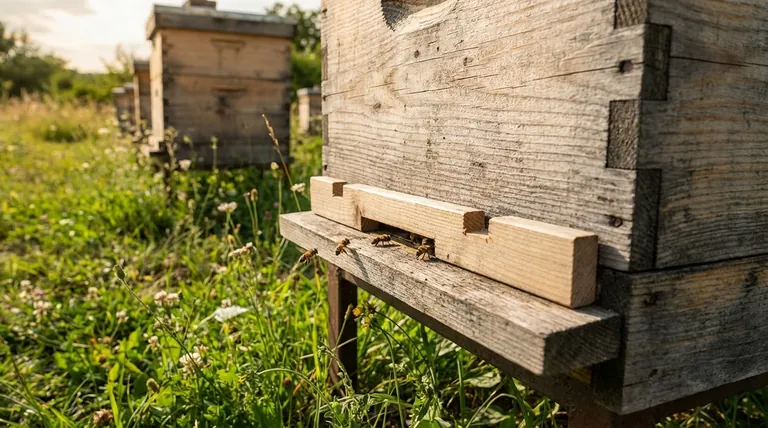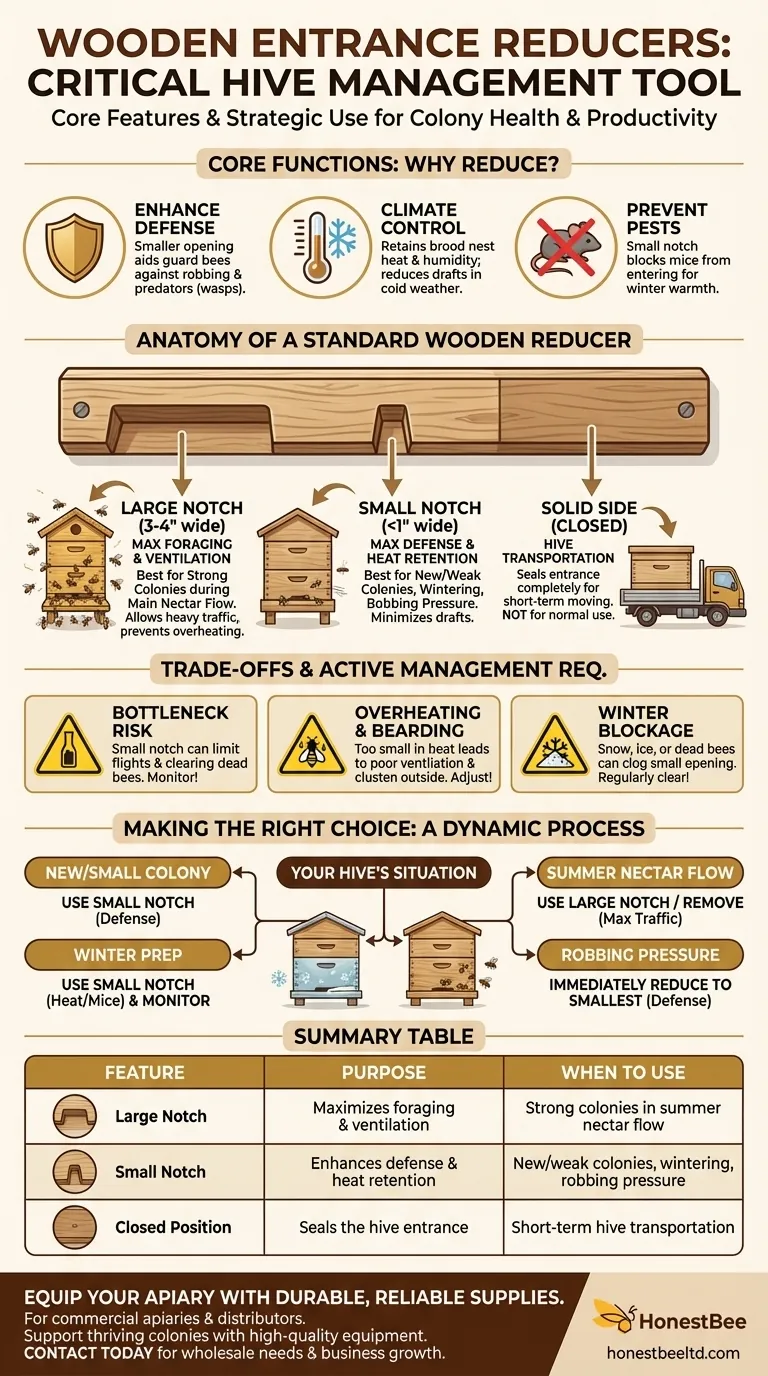At its core, a wooden entrance reducer is a simple rectangular bar of wood designed to fit into the main entrance of a Langstroth beehive. Its primary feature is a set of two different-sized notches cut into one of its long edges. By rotating the bar, a beekeeper can select the large notch, the small notch, or the solid side to control the size of the hive's opening.
The features of a wooden entrance reducer are not just its physical notches; they represent a critical management tool. Understanding why and when to use each setting is fundamental to regulating hive defense, climate control, and overall colony health.

The Core Function: Why Reduce an Entrance?
A beehive's entrance is its most vulnerable point. Controlling its size is a key technique for helping a colony thrive, especially when it is not at peak strength.
Enhancing Hive Defense
A smaller entrance is easier for guard bees to defend. This is critical for new or weak colonies that are susceptible to robbing from stronger hives, wasps, or other predators.
Aiding in Climate Control
In colder weather, a large opening creates a significant draft and heat loss. Reducing the entrance helps the colony maintain its internal brood nest temperature and humidity with less effort and fewer resources.
Preventing Pests
During late fall and winter, mice often seek warmth and food inside a beehive. A small entrance notch is specifically designed to be large enough for bees but too small for a mouse to enter.
Anatomy of a Standard Wooden Reducer
A typical reducer offers three, sometimes four, distinct settings. Each serves a specific purpose depending on the season and the colony's strength.
The Large Notch
This opening, often around 3-4 inches wide, is used for established, healthy colonies during the main nectar flow. It allows for heavy foraging traffic and provides adequate ventilation to prevent the hive from overheating.
The Small Notch
This notch is typically less than an inch wide. It's used for newly installed packages or nucs, very weak colonies, or for wintering. It provides maximum defense and draft protection.
The "Closed" Position
By turning the reducer to its solid, uncut side, you can completely seal the hive entrance. This is used exclusively for the short-term transportation of a hive to a new location.
Understanding the Trade-offs and Limitations
While essential, the standard wooden reducer is not a perfect tool. Its "one-size-fits-all" design can present challenges that require active management.
The "One-Size-Fits-All" Problem
As noted in many beekeeping guides, the "small" notch on a commercially produced reducer is often too small. It can create a bottleneck, limiting the colony's ability to conduct orientation flights or effectively clear out dead bees.
Risk of Overheating and Poor Ventilation
Using an entrance that is too small for a strong colony during warm weather can be disastrous. It traps heat and humidity, reduces foraging efficiency, and can lead to "bearding," where a large mass of bees clusters on the outside of the hive.
Potential for Winter Blockage
The small winter opening can become clogged with snow, ice, or the colony's own dead bees. If not monitored and cleared, this can trap the colony, leading to a lack of oxygen and hive death.
Making the Right Choice for Your Hive
Selecting the correct entrance size is a dynamic process that reflects the needs of your specific colony.
- If you are installing a new, small colony: Start with the small notch to help the bees defend their new home from robbers.
- If your colony is strong during a summer nectar flow: Remove the reducer entirely to maximize ventilation and foraging traffic.
- If you are preparing a hive for winter: Use the small notch to conserve heat and block mice, but monitor it regularly for blockages.
- If you observe robbing pressure from wasps or other bees: Immediately reduce the entrance to the smallest notch the colony can manage to aid their defense.
Ultimately, the entrance reducer is a simple device that enables you to respond directly to the changing needs of your colony throughout the year.
Summary Table:
| Feature | Purpose | When to Use |
|---|---|---|
| Large Notch | Maximizes foraging & ventilation | Strong colonies in summer nectar flow |
| Small Notch | Enhances defense & heat retention | New/weak colonies, wintering, robbing pressure |
| Closed Position | Seals the hive entrance | Short-term hive transportation |
Equip your apiary with durable, reliable supplies from HONESTBEE.
For commercial apiaries and distributors, proper equipment like entrance reducers is fundamental to successful hive management. Our wholesale-focused operations ensure you get the high-quality beekeeping supplies you need to protect your investment and support thriving colonies.
Contact HONESTBEE today to discuss your supply needs and discover how we can support your business's growth.
Visual Guide

Related Products
- Beehive Entrance Reducer Guardian Metal Hive Entrance for Bees
- Multi-Functional Sliding Hive Entrance for Beekeeping
- Multi-Functional Rotary Hive Entrance Disc for Beekeeping
- Professional Reversible Beehive Hive Entrance
- HONESTBEE Professional Long Handled Hive Tool with Precision Cutting Blade
People Also Ask
- What should be done after transferring frames to the new hive? Essential Steps for a Secure Colony
- What is the purpose of placing an object in front of the hive entrance after a move? A Guide to Forced Reorientation
- How big should a beehive entrance be? Optimize for Colony Health & Honey Production
- How can a Langstroth hive entrance be adjusted? Mimic Natural Bee Preferences for a Healthier Hive
- What are the two functions of the Entrance Reducer? Master Hive Defense and Safe Transport



















